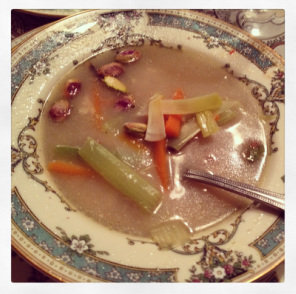Croquettes are little nuggets of ground meat or vegetables bound with eggs or a sauce, coated in breadcrumbs and then fried until golden and crunchy on the outside. The name comes from their deliciously crispy exterior; croquette is derived from the French verb croquer, or crunch. These flavorful delicacies were very popular in the 19th century, found throughout cookbooks from the era.
According to food historians, croquette-type dishes likely evolved from Ancient Roman rissoles: minced, spiced meat bound with fillers, carefully shaped, and deep fried. Over the years, recipes have varied depending on regional culture, cuisine, and period. The main difference between rissoles and croquettes is the former is wrapped in pastry while the latter is rolled in breadcrumbs. But they are basically interchangeable in the way they are cooked, presented and served. Although references to "Croquettes" appear in print in the early 18th century, the earliest recipes found in English/American cookbooks date to the early 19th century.
There is a vast range of potential ingredients for croquettes -- meat, rice, cheese, fish, pasta and vegetables have all been enjoyed in croquette form. And while chicken was the preferred type in the 1800s, mashed potato is the most common croquette filling today. Potato croquettes are sometimes called potato balls. When the croquettes are shaped flat, they are also called “a la duchesse.”
I followed the chicken croquette recipe of Philadelphia black caterer, Peter Augustine. Augustine came from the West Indies, learned the catering trade from Robert Bogle (who was also a black caterer), and established his business in Philadelphia in 1816. Philadelphia was an unofficial center for black caterers, and like his equally successful contemporaries James Prosser, Henry Minton and John Trower, Augustine created a catering empire when opportunities for blacks were extremely limited. He became very wealthy and created employment opportunities for the black community. He trained wait staff and other crew in the production of food events. Augustine also provided china, tablecloths, tables, chairs, and other catering equipment he rented to his clients for their events.
Although this dish is suitable as either an appetizer or main dish and would be a perfect addition for a holiday table, it would shine at a casual event as well. The most important thing for this recipe is to mince the chicken very fine (I use my food processor), or to use mashed vegetables if doing that way. Next, the filling is soaked in a white sauce. For some reason, the white sauce in the Augustine recipe says to boil the milk first (then add flour and butter), whereas usually it is the other way around. Feel free to do whatever you prefer, but I’m giving instructions for doing the typical way.
Augustine’s Chicken Croquettes
- 9-10 cups finely chopped chicken; or 6 cups chopped chicken plus 2 cups breadcrumbs (I used a 2-pound package of boneless chicken breast)
- 3 cups milk or cream
- 1 stick of butter
- 2 tbsp. flour
- ½ cup minced onion
- 1 ½ tsp salt
- ¼ tsp cayenne pepper
- 1 tsp mace
- Fine breadcrumbs, about 2 cups
- 1 egg, beaten
- Canola or vegetable oil
- Chop chicken very fine and season with salt, cayenne and mace. Set aside.
- Melt butter over medium heat in a large saucepan. Whisk in the flour and onion until smooth. Gradually whisk in the milk. Bring to a boil; cook and stir for 2 minutes or until thickened.
- Add chicken and mix well. Chill the mixture by placing in the refrigerator for about 1 hour.
- Place the egg in a small bowl. Place breadcrumbs in a shallow dish.
- With wet hands, take chicken mixture and form into small round or cone shapes, roll lightly in breadcrumbs, dip in the egg and then fully coat with breadcrumbs and place on a clean platter.
- When done forming the croquette shapes, heat a 1/2 inch of oil over med-high heat in a cast iron skillet. When shimmering, fry 3-4 croquettes at a time, turning twice, until golden brown, about 3 minutes (don’t fry too many at a time or the boiling oil will cool too much, and the croquettes will become greasy). Transfer to a wire rack or paper towel set on a baking sheet.
- Enjoy! Serve with a sour cream dip, hot sauce or honey mustard if desired.
Yield: about 32 croquettes
Sources: John Ayto, An A to Z of Food and Drink, Oxford University Press: Oxford, 2002, p. 98; Robin Caldwell, Black Southern Caterers: A History of Enterprise and Culinary Good Taste, October 28, 2019; William Woys Weaver, 35 Receipts from The Larder Invaded, Philadelphia: The Library Company of Philadelphia, 1986; The Food Timeline






0 Comments